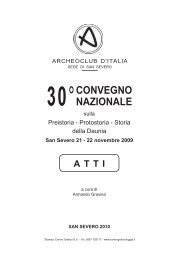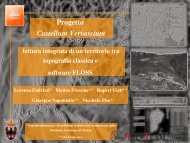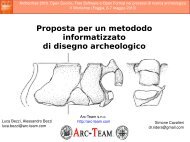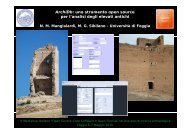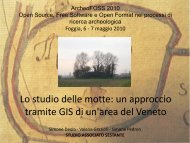Proposta per una carta archeologica di Verona copia
Proposta per una carta archeologica di Verona copia
Proposta per una carta archeologica di Verona copia
You also want an ePaper? Increase the reach of your titles
YUMPU automatically turns print PDFs into web optimized ePapers that Google loves.
<strong>Proposta</strong> <strong>per</strong> <strong>una</strong> <strong>carta</strong> <strong>archeologica</strong> <strong>di</strong> <strong>Verona</strong>: un prototipo con softwarelibero realizzato tramite alcune tesi <strong>di</strong> laurea.L’iniziativa della stesura <strong>di</strong> <strong>una</strong> <strong>carta</strong> <strong>archeologica</strong> informatizzata della <strong>Verona</strong> romana nasce dallacollaborazione tra l’Università degli Stu<strong>di</strong> <strong>di</strong> <strong>Verona</strong> e la Soprintendenza <strong>per</strong> i Beni Archeologici delVeneto - Nucleo O<strong>per</strong>ativo <strong>di</strong> <strong>Verona</strong>.Il progetto ha preso avvio da quattro tesi <strong>di</strong> laurea specialistica in Topografia dell’Italia antica volte adapprofon<strong>di</strong>re alcuni contesti archeologici della <strong>Verona</strong> romana portati alla luce dalla Soprintendenzastessa.La strutturazione <strong>di</strong> questo Sistema Informativo Territoriale è avvenuta attraverso l’uso <strong>di</strong> softwareOpen Source, come OpenJUMP e QGIS, a vantaggio <strong>di</strong> un consistente risparmio <strong>di</strong> tipo economico e<strong>di</strong> un’ampia con<strong>di</strong>visione dei dati.Infatti, ciò ha consentito <strong>di</strong> utilizzare <strong>per</strong> i lavori <strong>di</strong> tesi più copie degli stessi Software senza costiaggiuntivi e ha consentito <strong>di</strong> programmare il trasferimento dei dati e del Sistema <strong>di</strong> consultazione allaSoprintendenza <strong>per</strong> i Beni archeologici, senza i vincoli <strong>di</strong> acquisto delle licenze.Per la base cartografica <strong>di</strong> riferimento è stata scelta la C.T.R. (Carta Tecnica Regionale in scala 1:5000-Roma 40 Gauss Boaga) allo scopo <strong>di</strong> utilizzare <strong>una</strong> base comune con altri enti, poiché questa è giàadottata dall’Ufficio <strong>per</strong> il Sistema Informativo Territoriale del Comune <strong>di</strong> <strong>Verona</strong> e dall’ufficioveronese della Soprintendenza <strong>per</strong> i Beni Archeologici del Veneto, oltre che <strong>per</strong>ché è liberamenteacquisibile dal sito internet della Regione Veneto.Si è proceduto quin<strong>di</strong> all’informatizzazione delle planimetrie <strong>di</strong> scavo, <strong>di</strong>sponibili solo in formato<strong>carta</strong>ceo, le quali sono state acquisite tramite scansioni e georeferite sulla C.T.R. Data la precisione <strong>di</strong>partenza delle planimetrie, si è prestata particolare attenzione nell’in<strong>di</strong>viduare un sistema <strong>per</strong> attribuirecoor<strong>di</strong>nate geografiche mantenendo fisse le proporzioni delle immagini. Il posizionamento è statotalvolta <strong>di</strong>fficile, <strong>per</strong>ché spesso gli scavi più datati non fornivano informazioni precise in merito allalocalizzazione del sito e <strong>per</strong>ciò è stata necessaria un’attenta lettura della documentazione d’archivio.Successivamente, le planimetrie sono state vettorializzate ed i dati emersi dalle ricerche sono statiinseriti all’interno del database del GIS e sfruttati <strong>per</strong> eseguire interrogazioni e creare layer cheevidenziano <strong>di</strong> volta in volta il tipo <strong>di</strong> dato che si è deciso <strong>di</strong> selezionare (strutture <strong>di</strong> un determinatosecolo, e<strong>di</strong>fici produttivi, funerari, ecc.), consentendo quin<strong>di</strong> <strong>di</strong> ottenere <strong>una</strong> visione coerente e puntuale<strong>di</strong> dati trasversali e complessi all’interno <strong>di</strong> <strong>una</strong> mole <strong>di</strong> informazioni nella quale finora era stato<strong>di</strong>fficoltoso addentrarsi, oltre che <strong>una</strong> consultazione semplificata più adatta al grande pubblico. Nehanno beneficiato <strong>per</strong> prime le tesi specialistiche dalle quali è partito il progetto, le quali sono giuntetalvolta a conclusioni avallate proprio dall’evidenza dei dati inseriti nel GIS: la stesura della CartaArcheologica informatizzata <strong>per</strong> questo settore della città antica ha <strong>per</strong>messo <strong>di</strong> delinearne l’assettourbanistico evidenziando i rapporti esistenti fra i vari contesti archeologici.Visti i risultati ottenuti si auspica che il progetto possa proseguire ampliando il raggio della ricercaall’intera città antica e trasferendo i dati in un WebGIS a<strong>per</strong>to alla grande utenza.
AbstractThis initiative is a joint project by “Università degli Stu<strong>di</strong> <strong>di</strong> <strong>Verona</strong>” and “Soprintendenza <strong>per</strong> i BeniArcheologici del Veneto - Nucleo O<strong>per</strong>ativo <strong>di</strong> <strong>Verona</strong>” and stems from four master degree thesis in “Topografia dell’Italia antica”.This GIS was built using open source software (inclu<strong>di</strong>ng OpenJump, Qgis, and others) allowing easilysharing of the collected data and cost savings in terms of software licenses. It was possible to usemultiple instances of the software, inclu<strong>di</strong>ng deploying the system at the “ Soprintendenza <strong>per</strong> i Beniarcheologici”, without need for ad<strong>di</strong>tional licenses and/or ad<strong>di</strong>tional cost.The basis for the cartography is consisted of the “C.T.R. (Carta Tecnica Regionale in scala 1:5000-Roma 40 Gauss Boaga)” since this is the most widely used by <strong>di</strong>fferent institutions and is freelyavailable.The first step was to <strong>di</strong>gitize available maps of the <strong>di</strong>ggings, while trying to avoid <strong>di</strong>stortions. Mapswere later positioned over the C.T.R, a typically <strong>di</strong>fficult task, especially for old maps which lack dataon exact positioning and for which extensive research in the archives was necessary. Afterwards, themaps are vectorized and the data collected in the <strong>di</strong>ggings inserted into the GIS database.At this point, it was possible to dynamically create <strong>di</strong>fferent layers of analysis, allowing the user tochoose which data to visualize (e.g. filtering data by <strong>per</strong>iod, getting all buil<strong>di</strong>ng related to a particularfunction, and so forth). This allows users to focus only on the data deemed relevant inside instead ofthe huge amount of collected information, which by its complex nature is <strong>di</strong>fficult to understand as awhole.The first to take advantage of this feature were the authors the master thesis, who could back up theirconclusions with data from the GIS. Having all the data concerning this ancient site gathered in oneplace, allowed for the study of the structure of the city and to analyze the relationships between the<strong>di</strong>fferent archaeological contexts.Given the interesting results obtained, we hope the project will expand in the future, either byincreasing the area considered and by ad<strong>di</strong>ng new data. We also hope that at least a subset of the GISwill be available to the general public on a webGIS.
Fig. 1: Settore della città <strong>di</strong> <strong>Verona</strong> oggetto della <strong>carta</strong> <strong>archeologica</strong> informatizzataFig.2: Esempio <strong>di</strong> interrogazione dei dati.
Ente <strong>di</strong> referenzaUniversità degli Stu<strong>di</strong> <strong>di</strong> <strong>Verona</strong>Autore referenteElisa Zentilini tel. 0309133567 – 3479442412Mail: eli.zenti@libero.itAutoriTecla Gottar<strong>di</strong> – antea07@libero.itValeria Grazioli – pozzoinge@gmail.comPiergiovanna Grossi – piergiovanna.grossi@univr.itCecilia Zanetti – cecizeta@libero.itElisa Zentilini – eli.zenti@libero.it





